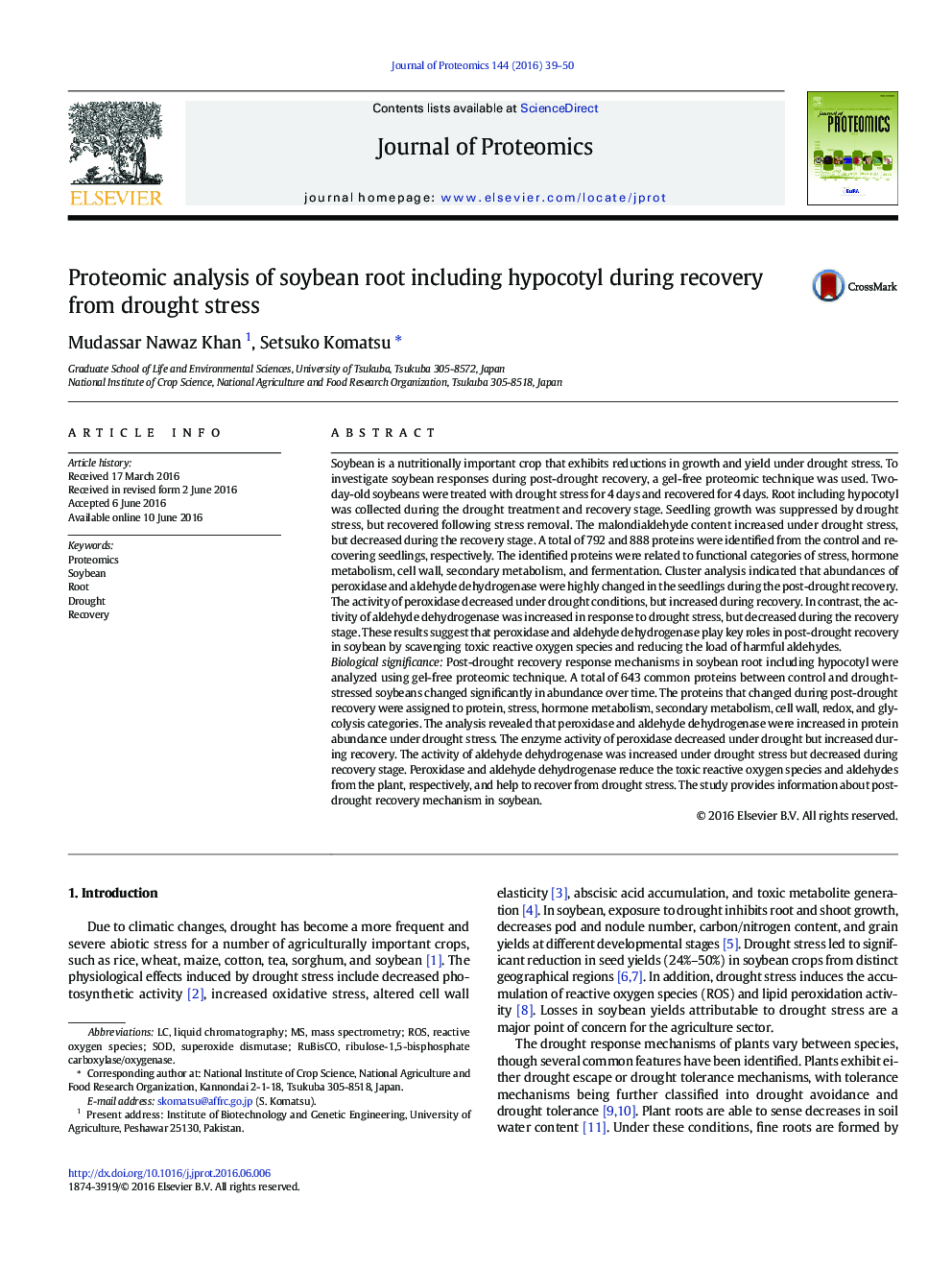| کد مقاله | کد نشریه | سال انتشار | مقاله انگلیسی | نسخه تمام متن |
|---|---|---|---|---|
| 1225123 | 1494737 | 2016 | 12 صفحه PDF | دانلود رایگان |
• Morphological, proteomic, and enzyme activity analyses of soybean during post-drought recovery were performed.
• In control, 792 proteins, whereas 888 proteins were changed in seedlings recovering after drought stress.
• Mainly changed proteins belonged to protein category between control and drought-stressed seedlings.
• Peroxidase activity was decreased under drought stress but increased during recovery.
• Aldehyde dehydrogenase activity was increased under drought but decreased during recovery stage.
Soybean is a nutritionally important crop that exhibits reductions in growth and yield under drought stress. To investigate soybean responses during post-drought recovery, a gel-free proteomic technique was used. Two-day-old soybeans were treated with drought stress for 4 days and recovered for 4 days. Root including hypocotyl was collected during the drought treatment and recovery stage. Seedling growth was suppressed by drought stress, but recovered following stress removal. The malondialdehyde content increased under drought stress, but decreased during the recovery stage. A total of 792 and 888 proteins were identified from the control and recovering seedlings, respectively. The identified proteins were related to functional categories of stress, hormone metabolism, cell wall, secondary metabolism, and fermentation. Cluster analysis indicated that abundances of peroxidase and aldehyde dehydrogenase were highly changed in the seedlings during the post-drought recovery. The activity of peroxidase decreased under drought conditions, but increased during recovery. In contrast, the activity of aldehyde dehydrogenase was increased in response to drought stress, but decreased during the recovery stage. These results suggest that peroxidase and aldehyde dehydrogenase play key roles in post-drought recovery in soybean by scavenging toxic reactive oxygen species and reducing the load of harmful aldehydes.Biological significancePost-drought recovery response mechanisms in soybean root including hypocotyl were analyzed using gel-free proteomic technique. A total of 643 common proteins between control and drought-stressed soybeans changed significantly in abundance over time. The proteins that changed during post-drought recovery were assigned to protein, stress, hormone metabolism, secondary metabolism, cell wall, redox, and glycolysis categories. The analysis revealed that peroxidase and aldehyde dehydrogenase were increased in protein abundance under drought stress. The enzyme activity of peroxidase decreased under drought but increased during recovery. The activity of aldehyde dehydrogenase was increased under drought stress but decreased during recovery stage. Peroxidase and aldehyde dehydrogenase reduce the toxic reactive oxygen species and aldehydes from the plant, respectively, and help to recover from drought stress. The study provides information about post-drought recovery mechanism in soybean.
Figure optionsDownload high-quality image (256 K)Download as PowerPoint slide
Journal: Journal of Proteomics - Volume 144, 20 July 2016, Pages 39–50
